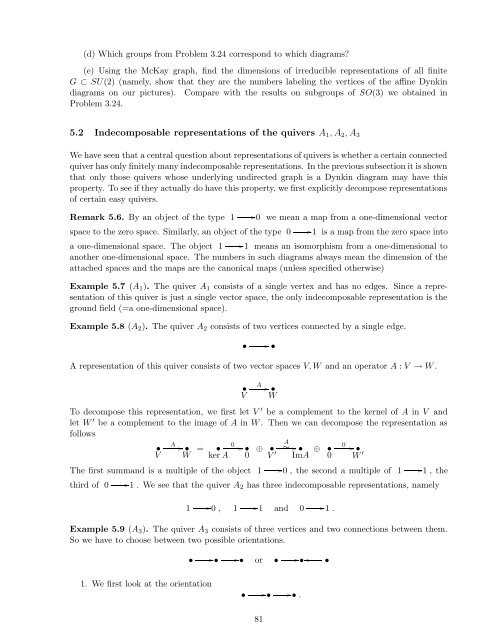Lecture notes for Introduction to Representation Theory
Lecture notes for Introduction to Representation Theory
Lecture notes for Introduction to Representation Theory
You also want an ePaper? Increase the reach of your titles
YUMPU automatically turns print PDFs into web optimized ePapers that Google loves.
(d) Which groups from Problem 3.24 correspond <strong>to</strong> which diagrams?<br />
(e) Using the McKay graph, find the dimensions of irreducible representations of all finite<br />
G → SU(2) (namely, show that they are the numbers labeling the vertices of the affine Dynkin<br />
diagrams on our pictures). Compare with the results on subgroups of SO(3) we obtained in<br />
Problem 3.24.<br />
5.2 Indecomposable representations of the quivers A 1 , A 2 , A 3<br />
We have seen that a central question about representations of quivers is whether a certain connected<br />
quiver has only finitely many indecomposable representations. In the previous subsection it is shown<br />
that only those quivers whose underlying undirected graph is a Dynkin diagram may have this<br />
property. To see if they actually do have this property, we first explicitly decompose representations<br />
of certain easy quivers.<br />
Remark 5.6. By an object of the type 1 0 we mean a map from a one-dimensional vec<strong>to</strong>r<br />
space <strong>to</strong> the zero space. Similarly, an object of the type 0 1 is a map from the zero space in<strong>to</strong><br />
a one-dimensional space. The object 1 1 means an isomorphism from a one-dimensional <strong>to</strong><br />
another one-dimensional space. The numbers in such diagrams always mean the dimension of the<br />
attached spaces and the maps are the canonical maps (unless specified otherwise)<br />
Example 5.7 (A 1 ). The quiver A 1 consists of a single vertex and has no edges. Since a representation<br />
of this quiver is just a single vec<strong>to</strong>r space, the only indecomposable representation is the<br />
ground field (=a one-dimensional space).<br />
Example 5.8 (A 2 ). The quiver A 2 consists of two vertices connected by a single edge.<br />
• •<br />
A representation of this quiver consists of two vec<strong>to</strong>r spaces V, W and an opera<strong>to</strong>r A : V ⊃ W .<br />
A<br />
V • W •<br />
To decompose this representation, we first let V be a complement <strong>to</strong> the kernel of A in V and<br />
let W be a complement <strong>to</strong> the image of A in W . Then we can decompose the representation as<br />
follows<br />
A<br />
A<br />
0 0 <br />
V • W • = ker • • •<br />
A 0 V <br />
• • • Im A 0 W <br />
The first summand is a multiple of the object 1 0 , the second a multiple of 1 1 , the<br />
third of 0 1 . We see that the quiver A 2 has three indecomposable representations, namely<br />
1 0 , 1 1 and 0 1 .<br />
Example 5.9 (A 3 ). The quiver A 3 consists of three vertices and two connections between them.<br />
So we have <strong>to</strong> choose between two possible orientations.<br />
• • • or • • •<br />
1. We first look at the orientation<br />
• • • .<br />
81

















